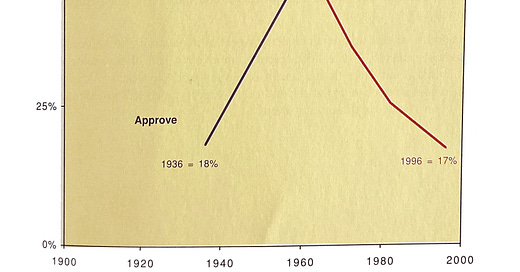“The past is a foreign country,” runs the famous first line of The Go-Between, a 1953 novel by L.P. Hartley. “They do things differently there.”
Every now and then, when I read history, or leaf through the pages of old magazines, I gasp. I love those moments. That’s when some condition of the modern world, some feature of our lives that we take for granted, some fixture of our present reality seemingly constant as gravity, is revealed to be the product of radical change. And not in the hazy mists of distant history. In living memory.
So “The Past is a Foreign Country” will be a recurring feature here — facts, charts, photos, ads or anything else that throws light on ways in which the present differs from the past.
I’ll also have a recurring feature called “It’s Not Even Past” (“The past is never dead,” wrote Faulkner, “it’s not even past”) that highlights evidence of the surprisingly strong influence of history today. These two will be the Yin and Yang of this newsletter.
First up: A quick look at what Americans thought about women working outside the home.
When George Gallup was inventing the modern popular opinion survey in the 1930s, one of the earliest questions he asked of Americans was, “should a married woman earn money if she has a husband capable of supporting her?”
The phrasing is important. Even in the 19th century, most people considered it acceptable for single women to hold a job. But when they got married, they had to give that up and stay home. If the husband lost his job, or couldn’t work for some other reason, it again became acceptable for the wife to take a job. But when the husband was back on his feet, she had to go home.
Labour shortages in factories during the First World War brought the first major challenge to that convention, but the social norm was largely restored when the war ended. Then came the Second World War, when women played a much larger role in factories and offices. Then came the second wave feminism of the 1960s.
Starting in 1972, the General Social Survey asked the following question: “Do you approve or disapprove of a married woman earning money in business or industry if she has a husband capable of supporting her?”
On this very basic matter of how people should live their lives, American society did a near-perfect polarity flip over 60 years.
By the way, this chart comes from The First Measured Century, a ridiculously interesting collection of charts summing up American life over the course of the 20th century. It was published in 2001 by the American Enterprise Institute.





Good article - very insightful. Of course women were the centre of most manufacture and service production up until the mid point of 19th century, when factories and big industry became dominant. Before that point, the booze you drank, the shirt you wore, the candles you read by, meals you ate, and the medicine you lived and died by were of home manufacture. If a woman worked outside of the home the pay was minimal, possibilities of abuse were great and that industry she was unable to do in the home was a significant loss to the family.